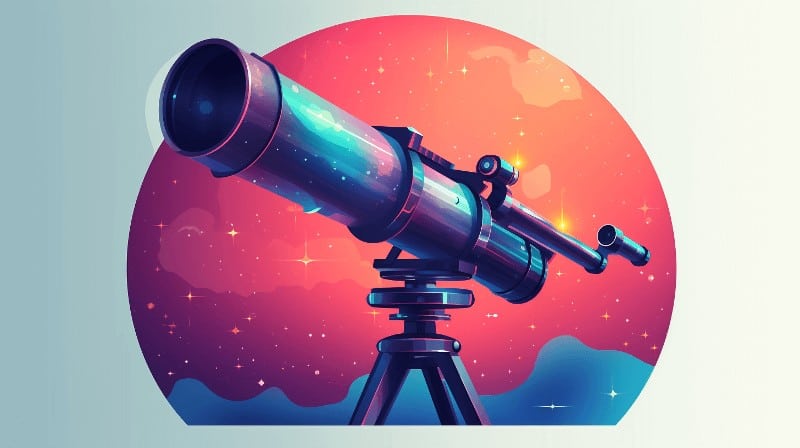With hundreds of options to choose from, it can be hard to know which telescope to buy.
I got it totally wrong with my first telescope and ended up wasting a lot of my time on something that wasn’t right for me. Now, after years of experience, I know what I should have gone for.
In this article, I recommend five options for the best telescopes for beginners. Each suits different budgets and needs, but are all suitable for people with no experience and are easy to set up and use.
Let’s get into it:
— Our Pick: Celestron StarSense Explorer LT 80AZ
— Best Portable: Celestron Travel Scope 70 DX
— Best Computerized: Celestron Nexstar 4SE
— Best for Viewing Planets and Galaxies: Celestron StarSense Explorer 8-inch Dobsonian
— Best Smart Telescope for Beginners: Unistellar Odyssey Pro
Best Telescopes for Beginners
Celestron StarSense Explorer LT 80AZ
Our Pick – Best Telescope for Beginners
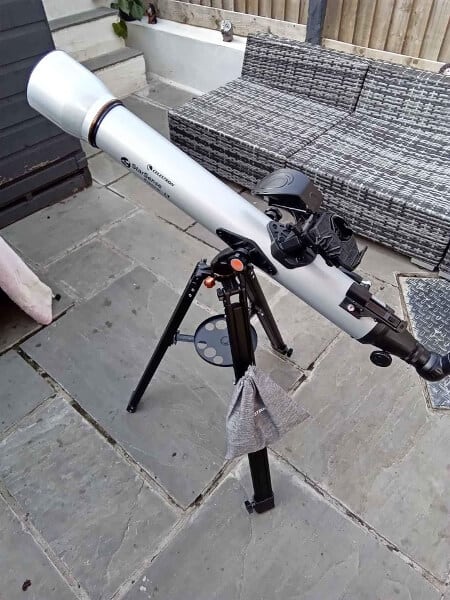
Newly released in the past few years, this is our recommendation for the best telescope for beginners in 2024.
What makes this great is the Starsense technology that allows the telescope to interact with your smartphone. This makes it extremely easy to know what’s currently visible in the night sky and how to find it.
Overall, this is what I recommend to anyone today asking “what’s the best telescope for beginners?”. The innovative smartphone interactivity is a fantastic feature and takes much of the difficulty out of finding things in the sky.
Essentially, it is a regular, manual telescope that you operate by hand, but when you attach your smartphone and use the app it gives you a map of the night sky and guides you to whatever planet, galaxy, or other astronomical object that you want to view.
This makes astronomy much easier and removes one of the frustrations that many beginners have – the time it takes to find something.
You can watch a quick video from Celestron here to show how it works in practice:
This model is a 3.1-inch refractor, and while there are larger options, it features a great balance between price, functionality and portability.
For example, its maximum useful magnification of 189x gives it enough power to provide stunning close-up views of the Moon, while also allowing you to enjoy smaller targets, such as the planets and distant galaxies.
With an assembled weight of 9 pounds, it’s still lightweight enough to be taken almost anywhere.
This is a great option for families and makes observing the night sky together fun It can be particularly engaging for older kids who are into astronomy.
There are other models in the StarSense Explorer range that are more powerful and have the same smartphone connectivity but are more expensive. See the 8-inch Dobsonian version below, or for a complete overview and comparison go to our article on Celestron Starsense Explorer Telescopes.
Pros
- The innovative design utilizes your smartphone to help you find things to look at in the night sky. No need for a cumbersome GOTO mount
- Mid-range power (aperture) will give you goods views of astronomical objects under clear skies
- Great value for the price
Cons
- More expensive than Celestron models that use the same telescope tube but lack the smartphone interactivity
- Relatively heavy and bulky compared to something like the Travel Scope outlined below which would be more suitable for travelling with
Key specifications
- Type: Reflector
- Aperture: 3.1-inch (80 mm)
- Focal Length: 35-inch (900 mm)
- Weight: 9.2 lbs (4.17 kg)
- Mount: Manual Alt-Azimuth
- Accessories: Two eyepieces, 2x Barlow lens, red dot finderscope, tripod
Smartphone App-Enabled Telescope
- Let your iPhone or Android phone take you on a guided tour of the night sky.
- The app tells you what’s in the sky based on your exact time & location. Follow the on-screen arrows to your desired target. When the bullseye turns green, it’s ready to view in the telescope’s eyepiece.
- View planets, brighter nebulae, galaxies, and more.
- Too bulky for easy travel
Celestron Travel Scope 70 DX
Best Portable Telescope for Beginners
As the name suggests, this telescope is portable enough to be taken almost anywhere. It’s easy to set up and also packs away nicely in the provided backpack.
This makes it the perfect choice for beginners to use either at home or while on a family trip.
This is the 70mm (2.8-inch) aperture version – there are others larger and smaller in the same range from Celestron – see our article on the Best Travel and Portable Telescopes.
This is about the very minimum you’d want in terms of aperture to be able to get good views of astronomical objects in the night sky.
It comes complete with a carry bag and tripod, as well as different eyepieces. You can also use your smartphone to take photos by attaching the adapter to the eyepiece.
Overall, this is a great travel telescope, but also great for home use and perfect for those wanting something that packs up neatly for easy storage and comes with all you need in one package.
Here’s a video overview from Celestron:
Pros
- Portable and perfect for travel, but also for easy use and storage at home
- All in one package, including backpack
- Inexpensive and good value for the price
- Easy to use, set up, and store
Cons
- The 70mm aperture is not huge and so will limit what you will be able to see (there is also a more powerful 80mm version that is a bit more expensive)
- Not GOTO
Key specifications
- Type: Refractor
- Aperture: 70 mm (2.8-inch)
- Focal Length: 400 mm (16-inch)
- Weight: 4.2 lbs (1.9 kg)
- Mount: Manual Alt-Azimuth
- Accessories: Backpack, Tripod, Erect Image Diagonal, 2 Eyepieces (10mm and 20mm)
Portable Refractor Telescope
- The Celestron 70mm Travel Scope features high-quality, fully-coated glass optics, a potent 70mm objective lens, a lightweight frame, and a custom backpack to carry it all.
- Equipped with 2 high-quality eyepieces (20mm and 10mm) plus bag, tripod, moon filter, 2x barlow, bluetooth shutter release, smartphone adapter and software.
- Perfect for families to use in the backyard or take on trips.
- Aperture not huge
Celestron NexStar 4SE
Best Computerized Telescope for Beginners
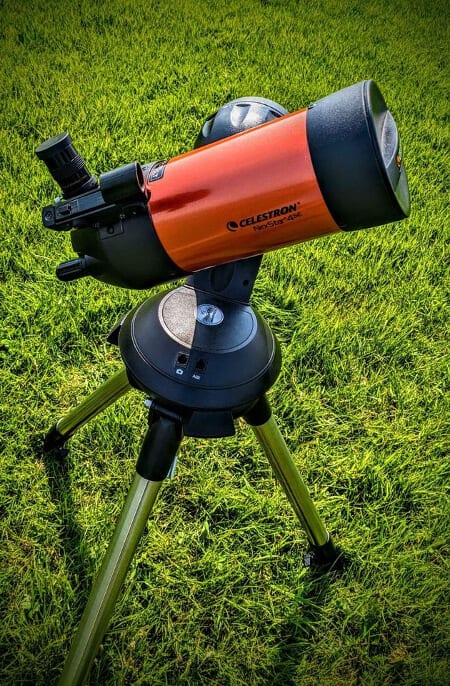
If you have the budget, then you might want to consider a smaller catadioptric/compound telescope with GoTo functionality, such as this Celestron NexStar 4SE.
The in-built GoTo technology means it will find whatever you choose from a database of over 40,000 objects. Simply push a few buttons on the supplied keypad and the telescope will then turn to point toward your selected target.
It ticks all the boxes to be a great telescope for beginners, but the computerized GOTO mount places it in a slightly higher price bracket.
Note that the “4” in the name refers to the 4-inch aperture, and there are other models in the range with larger apertures that will allow you to see fainter objects in more detail.
Pros
- GOTO technology automatically locates objects in the night sky for you at the press of a button on the hand controller
- Very small and compact
Cons
- More expensive than non-GOTO models
- The smallest in the NexStar SE range (see our Celestron Nexstar Comparison)
- Requires a power source
- Is heavier and more cumbersome than the non-GOTO models above
Key specifications
- Type: Catadioptric (Maksutov-Cassegrain)
- Aperture: 102 mm (4-inch)
- Focal Length: 1325 mm (52-inch)
- Weight: 21 lbs (9.5 kg)
- Mount: GoTo (Computerized) Alt-Azimuth
- Accessories: Red dot finderscope, star diagonal, two eyepieces (25 mm and 9 mm)
Great value computerized telescope
- The 4-inch primary mirror in this Maksutov-Cassegrain telescope packs enough light-gathering ability to observe the best that our Solar System has to offer, while retaining a compact form factor.
- Fully-automated GOTO mount featuring a database of more than 40,000 celestial objects that locates and tracks objects for you.
- Perfect for both beginners and advanced users
- The smallest in the NexStar SE range
- Requires a power source
- Heavier and more cumbersome than non-GOTO models
Celestron StarSense Explorer 8-inch Dobsonian
Best Telescope for Viewing Planets and Galaxies for Beginners
This is a brilliant and powerful telescope for viewing the night sky. The 8-inch aperture is huge and will provide you with amazing views.
Like the other Starsense Explorer telescope outlined above, it interacts with your smartphone to scan the night sky above you and guide you to what you can see on any night:
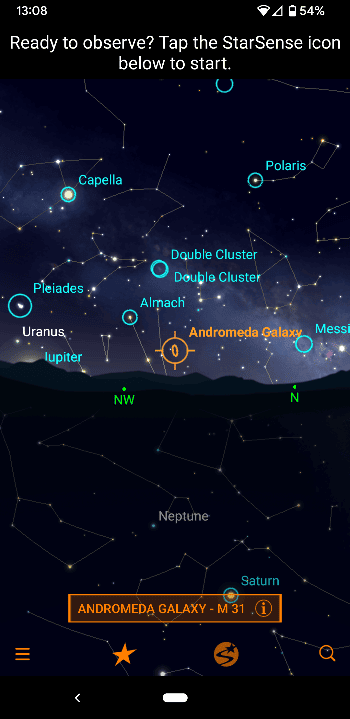
This telescope has a maximum useful magnification of 480x. This, coupled with the aperture, makes it great for viewing the planets, plus the thousands of galaxies that litter the night sky.
Watch this video from Celestron for a quick overview of this model and also to give you a good perspective of the size of it:
As you can see in the video, these high-aperture Dobsonian telescopes are big – the size of a grown man!
This is the biggest downside for me – the weight and lack of portability. It is really a permanent backyard scope. You therefore need to make sure you have the space to handle it.
For me, this is the “one-scope-to-rule-them-all” for families. The app makes it great for older kids and adults and the younger kids can still get a kick out of it.
Note there is also a 10-inch and 12-inch version of this telescope. These have the same pros and cons but magnified – i.e. even more powerful but also even larger, heavier, and more expensive.
Pros
- The large aperture means very high power and great views
- Starsense technology links your smartphone to your telescope to make it easy to observe the night sky
- Great value in terms of price to aperture
- No need for a GOTO mount
Cons
- Heavy and large. You need to consider where you will use it and store it.
- Not portable. You won’t be taking this on trips.
- More expensive than the more budget-friendly options above
Key specifications
- Type: Dobsonian Reflector
- Aperture: 203 mm (8-inch)
- Focal Length: 1200 mm (47-inch)
- Weight: 43.4 lbs (19.7 kg)
- Included accessories: 25 mm eyepiece, smartphone dock, red dot finderscope, base.
8-inch Dobsonian Smartphone App-Enabled Telescope
- Large 8-inch aperture parabolic primary mirror and high-reflectivity XLT optical coatings give you the power to view all the best celestial objects.
- StarSense Explorer app automatically generates a list of objects currently visible, including planets, nebulae, galaxies, star clusters and double stars.
- Manual altazimuth mount makes it easy to follow the on-screen arrows to your desired target.
- Big and heavy
Unistellar Odyssey Pro
Best Smart Telescope for Beginners
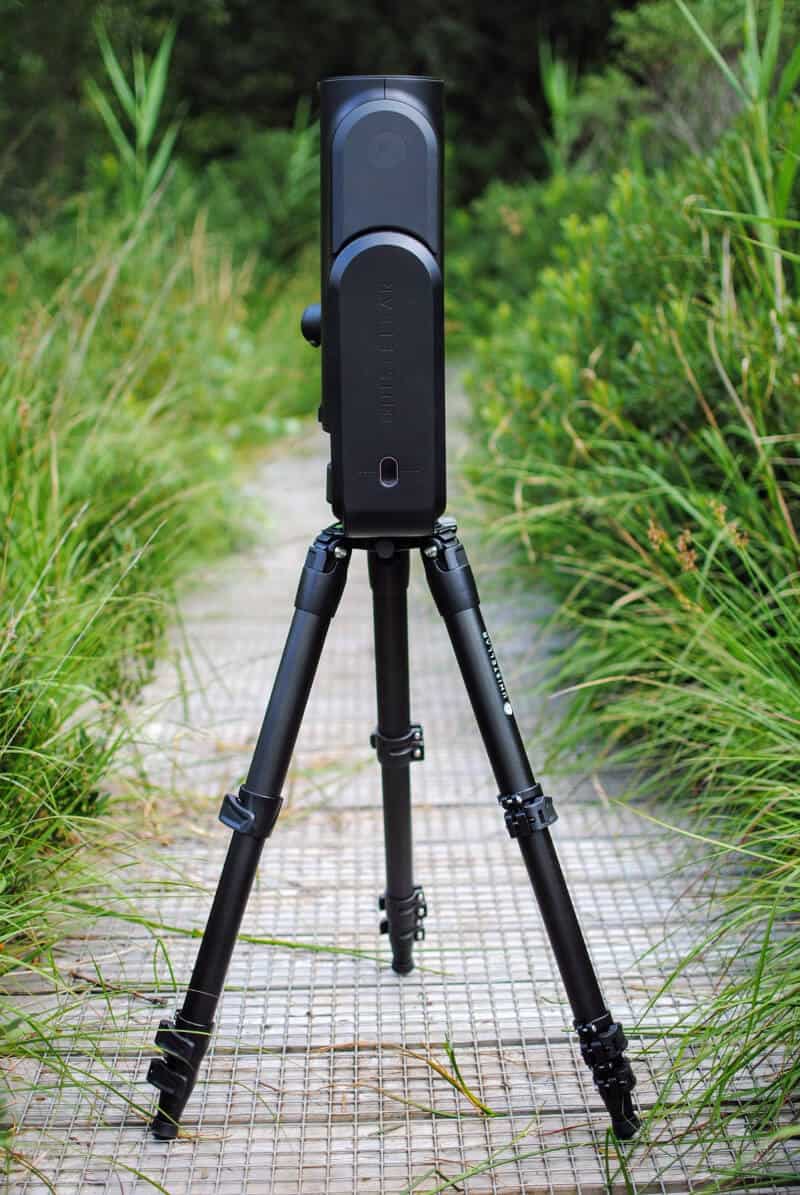
Lastly, this is something quite different from the other options in that it is one of the new smart telescopes that have entered the market in the past few years.
This is the Unistellar Odyssey Pro that was released in 2024.
In short, it’s a fully automated telescope and imaging system that you control with your smartphone. It automatically works out where you are and what you can see at that time, and you then choose your target from the list.
Here’s how it works differently from a regular GOTO telescope:
- It has a built-in camera that allows it to take images of deep sky objects and send them directly to your phone.
- It builds the images by gathering light over time, making it much better for viewing objects in cities and towns that are light-polluted.
This model is particularly easy to use and so great for beginners.
Watch our review here:
It should be noted that this is significantly more expensive than the other options above.
If you want to read more about this smart telescope and the other options of different prices, see our article on the Best Smart Telescopes or watch this video:
Pros
- Super easy to use, simple set up in minutes and operated via your smartphone
- Great views from light-polluted areas
- Easy astrophotography and image sharing
- Get involved in Citizen Science initiatives
- No other accessories are needed, although an additional backpack can be purchased
Cons
- Expensive when compared to regular telescopes
Key specifications
- Type: Smart Telescope
- Aperture: 3.3 inch (85 mm)
- Focal Length: 320 mm (12.6 inch)
- Weight: 14 lbs (6.5 kg)
Premium Smart Telescope
- Easy to use and perfect for complete beginners
- Features eyepiece for live viewing of the night sky
- Portable with a compact size and light weight
- Lower spec than premium alternatives
- Premium price

Best Telescope for Beginners Buying Guide
What is best for you to buy will depend on a number of factors that differ for each individual’s circumstances.
There are four things in particular to consider:
- What you will be able to see
- How easy it will be to use
- How practical it is for you
- How much you want to spend
What do you want to see through it?
Obviously, you want a telescope that allows you to see as much as possible, but this needs to be balanced with other factors.
In general, the key thing is aperture. The larger the aperture, the more light it can gather. This not only means seeing fainter objects, but also improved image brightness and greater detail.
However there are some different specifications you can look for if you think you might be more interested in viewing planets or deep sky objects like galaxies and nebulae.
Planets
The best telescopes for viewing the planets have a longer focal length (for higher magnification) and a larger aperture, which will improve the brightness of the image and the amount of detail you can see.
Although the planets are much closer than distant nebulae and star clusters, they’re also much smaller, so you’ll need a higher magnification to help you see them more clearly. Both magnification and aperture will also help you to spot the moons too.
Deep Sky Objects
While you can see some deep sky objects with the naked eye, a quality beginner telescope will improve that dramatically.
However, if you want to seriously devote some time to observing deep-sky objects, you should consider a telescope with an aperture of at least 8 inches (200+ mm) or more.
How easy will it be for you to use?
Are you a beginner or experienced? How much time can you dedicate to learning? Is it for a young child, teenager or adult?
You’ll need to decide if you (or the person using it) are able to invest the time in learning how to use it, or if it’s more of a fun thing to have around and use occasionally.
If it’s the latter, then you’ll likely favor a GoTo or smart telescope, as this will make it much easier to find your targets.
How practical is it for your circumstances?
Some telescopes are small and pack up easily, but others can be heavy and awkward to store.
Do you have space for a large telescope in your house or would you need to pack it away? Also, do you want something you can take on trips?
Size, weight, portability, and how easy it is to store, are all important factors that can easily be overlooked.
For my first telescope, I was ambitious and bought a large reflector telescope. Not only was it heavy, but it was also awkward to store. It was a great telescope, but it wasn’t the best choice for an apartment in a city.
If I were to make that decision now, I’d go for a smaller, more portable model and then upgrade once I had my own home.
It’s also worth noting that the performance of a telescope depends on your location, and how dark your skies are.
If you live in or near a town or city, you’ll find that only the brightest stars will be visible, while many of the fainter objects may be lost completely.
What your budget is?
The big one – how much do you want to spend?
To an extent, the more you can afford the more you can expect from a telescope’s performance, but it’s best to work out what you are prepared to spend and then go for the one most suitable for you in your price range.
In our opinion, the perfect beginner’s telescope would:
- Be reasonably small, light and portable,
- Have a large aperture (allowing you to see faint objects and details), and
- Have GoTo functionality (making it easier to use).
Not surprisingly, the telescopes that have all those features are more expensive, and this is typically what you can expect in the higher-range catadioptric telescopes now available.
Depending on your budget, you may want to work out what you are prepared to spend and then see what you are prepared to compromise on.
For instance, is size and portability an issue to you? If not, get a big reflector. If so, get a refractor or catadioptric telescope and sacrifice some aperture in exchange for a smaller size telescope.
Or if you want to learn how to locate objects yourself, then maybe skip the GoTo and save money that way.
There is no perfect answer, but there are plenty of great models and we recommend some of these above.
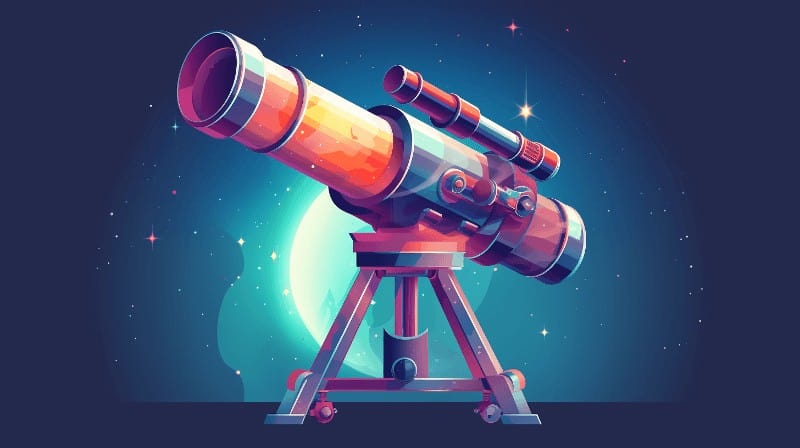
FAQs: Telescopes for Beginners
What’s the best telescope for kids?
A small tabletop reflector, or a portable refractor like the Celestron Travel Scope is a great option.
See our guide to the best telescopes for kids for more on this.
What about astronomy binoculars?
Astronomy binoculars can be great and have some advantages to telescopes, such as being smaller, easier to use and less expensive. Plus, of course, you can take them anywhere.
Besides these advantages, binoculars are also a great way to learn how to find some deep sky objects, as it’s often easier to scan the sky with binoculars than it is through a finderscope. Plus, they’re the ultimate grab ‘n go accessory for when the skies suddenly clear or you don’t have much time.
If you want to know more, read our article on the Best Astronomy Binoculars.
What telescope accessories do I need (and what do they do)?
Eyepieces are essential and change the magnification and field of view.
Barlow lenses are optional and will increase the magnification of any eyepiece used with them.
Finderscopes are used to help you locate objects in the night sky, but sometimes a very low-powered eyepiece can be more useful

Verdict: Best Telescopes for Beginners
These are my recommendations for the best telescopes for beginners to suit different requirements and budgets:
- Celestron StarSense Explorer LT 80AZ (Our Pick – Best Telescope for Beginners)
- Celestron Travel Scope 70 DX (Best Portable Telescope for Beginners)
- Celestron Nexstar 4SE (Best Computerized Telescope for Beginners)
- Celestron StarSense Explorer 8-inch Dobsonian (Best Telescope for Viewing Planets and Galaxies for Beginners)
- Unistellar Odyssey Pro (Best Smart Telescope for Beginners)


